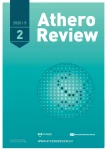Very low LDL cholesterol in acute coronary syndrome
Authors:
Jan Piťha 1,2
Authors‘ workplace:
Interní klinika 2. LF UK a FN Motol, Praha
1; Centrum experimentální medicíny IKEM, Praha
2
Published in:
AtheroRev 2020; 5(2): 93-97
Category:
Overview
Recommended very low target values of LDL cholesterol (less than 1.4, and 1.0 mmol/l in the case of recurrent events) are to be reached primary in patients with acute coronary syndrome (ACS), which are at the highest risk for subsequent events. Therefore, in these patients, dyslipidemia therapy should be initiated as soon and as aggressively as possible. In this context some uncertainties could be faced in patients with recent ACS and with very low LDL cholesterol levels (below 1.4 mmol/l). In the following article we focused on some practical aspects in the treatment of these patients, emphasizing that in most cases pharmacological treatment is absolutely needed even in this group. In principle, in patients at such risk there is no dangerously low LDL cholesterol level achieved by hypolipidemic treatment.
Keywords:
acute coronary syndrome – hypolipidemic therapy – low LDL cholesterol
Sources
- Cohen JC, Boerwinkle E, Mosley TH Jr et al. Sequence variations in PCSK9, low LDL, and protection against coronary heart disease. N Engl J Med 2006; 354(12): 1264–1272. Dostupné z DOI: <http://dx.doi.org/10.1056/NEJMoa054013>.
- Chambless L, Keil U, Dobson A et al. Population versus clinical view of case fatality from acute coronary heart disease: results from the WHO MONICA Project 1985–1990. Multinational MONItoring of Trends and Determinants in CArdiovascular Disease. Circulation 1997; 96(11): 3849–3859. Dostupné z DOI: <http://dx.doi.org/10.1161/01.cir.96.11.3849>.
- Dutta P, Courties G, Wei Y et al. Myocardial infarction accelerates atherosclerosis. Nature 2012; 487(7407): 325–329. Dostupné z DOI: <http://dx.doi.org/10.1038/nature11260>.
- Ridker PM, Everett BM, Thuren T et al. CANTOS Trial Group. Antiinflammatory Therapy with Canakinumab for Atherosclerotic Disease. N Engl J Med 2017; 377(12): 1119–1131. Dostupné z DOI: <http://dx.doi.org/10.1056/NEJMoa1707914>.
- Tardif JC, Kouz S, Waters DD et al. Efficacy and Safety of Low-Dose Colchicine after Myocardial Infarction. N Engl J Med 2019; 381(26): 2497–2505. Dostupné z DOI: <http://dx.doi.org/10.1056/NEJMoa1912388>.
- Ridker PM, Everett BM, Pradhan A et al. [CIRT Investigators]. Low-Dose Methotrexate for the Prevention of Atherosclerotic Events. N Engl J Med 2019; 380(8): 752–762. Dostupné z DOI: <http://dx.doi.org/10.1056/NEJMoa1809798>.
- Welty FK. Hypobetalipoproteinemia and abetalipoproteinemia. Curr Opin Lipidol 2014; 25(3): 161–168. Dostupné z DOI: <http://dx.doi.org/10.1097/MOL.0000000000000072>.
- Moghadasian MH, Frohlich JJ, Saleem et al. Surgical management of dyslipidemia: clinical and experimental evidence. J Invest Surg 2001; 14(2): 71–78. Dostupné z DOI: <http://dx.doi.org/10.1080/08941930152024183>.
- Giugliano RP, Pedersen TR, Park JG, et al. [FOURIER Investigators]. Clinical efficacy and safety of achieving very low LDL-cholesterol concentrations with the PCSK9 inhibitor evolocumab: a prespecified secondary analysis of the FOURIER trial. Lancet 2017; 390(10106): 1962–1971. Dostupné z DOI: <http://dx.doi.org/10.1016/S0140–6736(17)32290–0>.
- Jukema JW, Szarek M, Zijlstra LE et al. [ODYSSEY OUTCOMES Committees and Investigators]. Alirocumab in Patients With Polyvascular Disease and Recent Acute Coronary Syndrome: ODYSSEY OUTCOMES Trial. J Am Coll Cardiol 2019; 74(9): 1167–1176. Dostupné z DOI: <http://dx.doi.org/10.1016/j.jacc.2019.03.013>.
- [Authors/Task Force Members; ESC Committee for Practice Guidelines (CPG); ESC National Cardiac Societies]. 2019 ESC/EAS guidelines for the management of dyslipidaemias: Lipid modification to reduce cardiovascular risk. Atherosclerosis 2019; 290: 140–205. Dostupné z DOI: <http://dx.doi.org/10.1016/j.atherosclerosis.2019.08.014>. Erratum in Erratum to “2019 ESC/EAS guidelines for the management of dyslipidemias: Lipid modification to reduce cardiovascular risk” [Atherosclerosis 290(2019) 140–205]. [Atherosclerosis. 2020]. Corrigendum to “2019 ESC/EAS Guidelines for the management of dyslipidaemias: lipid modification to reduce cardiovascular risk” [Atherosclerosis 290 (2019) 140–205]. [Atherosclerosis. 2020].
- Piťha J, Staněk V, Gebauerová M et al. Rizikový profil pacientů s akutním koronárním syndromem a hodnotou LDL-cholesterolu < 1,4 mmol/l. Vnitr Lek 2019; 65(12 Suppl 2): 2S18–2S19 (Abstr 32US).
- Pitt B, Loscalzo J, Ycas J, et al. Lipid levels after acute coronary syndromes. J Am Coll Cardiol 2008; 51(15): 1440–1445. Dostupné z DOI: <http://dx.doi.org/10.1016/j.jacc.2007.11.075>.
- Shrivastava AK, Singh HV, Raizada A et al. Serial measurement of lipid profile and inflammatory markers in patients with acute myocardial infarction. EXCLI J 2015; 14: 517–526. Dostupné z DOI: <http://dx.doi.org/10.17179/excli2014–671>.
- Balci B. The modification of serum lipids after acute coronary syndrome and importance in clinical practice. Curr Cardiol Rev 2011; 7(4): 272–276. Dostupné z DOI: <http://dx.doi.org/10.2174/157340311799960690>.
- Češka R, Táborský M, Vrablík M. Společné stanovisko odborných společností k předepisování PCSK9-inhibitorů. AtheroRev 2018; 3(3): 201–207.
- Cannon CP, Braunwald E, McCabe CH et al. Pravastatin or Atorvastatin Evaluation and Infection Therapy-Thrombolysis in Myocardial Infarction 22 Investigators. Intensive versus moderate lipid lowering with statins after acute coronary syndromes. N Engl J Med 2004; 350(15): 1495–1504. Dostupné z DOI: <http://dx.doi.org/10.1056/NEJMoa040583>. Erratum in N Engl J Med 2006; 354(7): 778.
- Cannon CP, Blazing MA, Giugliano RP et al. [IMPROVE-IT Investigators]. Ezetimibe Added to Statin Therapy after Acute Coronary Syndromes. N Engl J Med 2015; 372(25): 2387–2397. Dostupné z DOI: <http://dx.doi.org/10.1056/NEJMoa1410489>.
- Piťha J, Štulc T, Janota T et al. Léčba statiny u pacientů s akutním koronárním syndromem. Společné stanovisko České společnosti pro aterosklerózu, Pracovní skupiny akutní kardiologie České kardiologické společnosti a Pracovnej skupiny akútnej kardiológie Slovenskej kardiologickej spoločnosti. Interv Akut Kardiol 2012; 11(2): 89–90.
- Pella D, Gvozdjáková A, Lietava J et al. Myopatie asociovaná se statiny: klinické doporučení Slovenskej asociácie aterosklerózy a České společnosti pro aterosklerózu. AtheroRev 2016; 1(1): 7–13.
- Langsted A, Madsen CM, Nordestgaard BG. Contribution of remnant cholesterol to cardiovascular risk. J Intern Med 2020. Dostupné z DOI: <http://dx.doi.org/10.1111/joim.13059.>.
Labels
Angiology Diabetology Internal medicine Cardiology General practitioner for adultsArticle was published in
Athero Review

2020 Issue 2
Most read in this issue
- Very low LDL cholesterol in acute coronary syndrome
- Therapy with drugs containing the active ingredient LOMITAPIDE in patients with homozygous form of familial hypercholesterolemia: a statement of the committee of the Czech Society for Atherosclerosis
- LipitenCliDec Study – the profile of patients with uncontrolled arterial hypertension and/or dyslipidemia in primary care in the Czech Republic: the 2nd phase results
- Cardiovascular risk in patients with familial hypercholesterolemia. Do we rate it correctly?
